Complete Solutions to OBJECTIVE QUESTIONS AND ANSWERS of chapter HEREDITY AND EVOLUTION of Class 10 book with complete answers and questions
| Class 10 | BIOLOGY |
| Chapter | HEREDITY AND EVOLUTION |
| KUMAR PRAKASHAN | OBJECTIVE QUESTIONS AND ANSWERS |
| Number Of Questions | 100 |
| Academic Year | 2023-24 |
Fill in the missing details in the given chart:
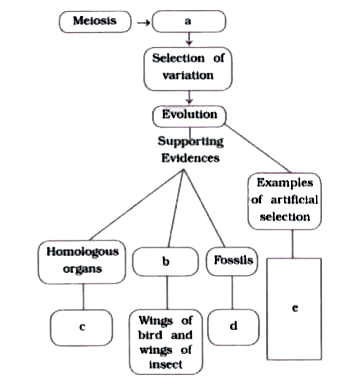 03:45View Solution
03:45View SolutionHow you can say that some animals rely entirely on environmental cues for sex determination ?
01:35View SolutionName two organisms which are now extinct and are studied from their fossils.
01:40View SolutionName five varieties of vegetables which have been produced from 'wild cabbage' by the process of artificial selection.
02:08View SolutionName the ancestor of the following : Broccoli, Kohlrabi, Kale
01:33View SolutionChoose the one term from the following, which includes the other three :
Broccoli, wild cabbage, cauliflower, cabbage.01:27View SolutionWhether pea plant is a self - pollinated plant or a cross pollinated one ?
01:51View SolutionGive the name of the flatworm which was the first to possess the eyes. State in which form and what it detects.
01:21View SolutionState the probability of birth of offspring as a son or a daughter.
01:51View SolutionHow do X and Y chromosomes differ ?
00:57View SolutionWhich character indicates that the birds are closely related to Dinosaurs ?
01:44View SolutionWhich evidences in the field of biology are considered to be the ancient documents ?
01:45View SolutionHow do we know that extinct species ever existed ?
01:36View SolutionFor what purpose is the study of fossils important ?
01:59View SolutionGive an example of homologous and analogous organs using same animals.
01:56View SolutionEvidences from which types of organs do not suggest any common ancestory in the course of evolution ?
01:53View SolutionDo all variations in a species have equal chances of surviving in the environment ? Why ?
02:11View SolutionWho forms the basis for evolutionary processes ?
03:11View SolutionWhat is earlobe ? Which are dominant and recessive variants respectively ?
01:55View SolutionAccording to Mendel's experiment, the tall plants in `F_(1)` generation were exactly the same as the tall plants of the parent generation ? Why ?
01:24View SolutionHow do germ cells make a single set of genes from the normal two copies in all other cells of body ?
01:22View SolutionCan asexually reproducing organisms follow similar rules of inheritance ? Why ?
01:59View SolutionDo tailless mice have tailless progeny ? Why or why not ?
01:18View SolutionExplain the word: Micro-evolution
03:59View SolutionWhat is called when two populations of a species cannot reproduce with each other ?
02:25View SolutionWhat is the meaning of characteristics ?
01:19View SolutionWhat allows us to make classification groups ?
02:08View SolutionWhen is it said that two species have a common ancestor ?
02:15View SolutionWhich fossil was found in the Narmada Valley a few years ago ?
01:27View SolutionWhich method is now extensively used for tracing evolutionary relationships ?
02:40View SolutionWhich tools have been used for studying human evolution ?
03:03View SolutionFrom where the genetic footprints of Homo sapiens can be traced ?
01:03View SolutionDefine: OR Explain the terms:
Heredity01:25View SolutionDefine: OR Explain the terms:
Trait01:13View SolutionDefine: OR Explain the terms:
Gene02:56View SolutionDefine: OR Explain the terms:
Sex determination01:44View SolutionDefine: OR Explain the terms:
Genetic drift03:32View SolutionDefine: OR Explain the terms:
Speciation03:29View SolutionDefine: OR Explain the terms:
Evolution03:01View SolutionDefine: OR Explain the terms:
Natural selection03:40View SolutionThe geographical isolation along with the variations leads to the formation of ……………………………..
01:48View SolutionThe classification of living organisms explain their …………………………….. relationships.
02:41View SolutionBroccoli has been developed from …………………………….. by artificial selection.
01:40View Solution…………………………….. is called the science of heredity and variations.
01:18View SolutionThe idea of evolution of species by natural selection was given by ……………………………..
01:47View SolutionSelection of …………………………….. by environmental factors forms the basis for evolutionary processes.
01:51View SolutionThe synthesis of enzymes in the cell is under the control of ……………………………..
01:17View SolutionThe growth of a pea plant depends on the amount of specific …………………………….. in the plant.
01:36View SolutionThe presence of Y-chromosome in human being is essential for being a ……………………………..
01:06View Solution…………………………….. provides diversity without any adaptation.
04:08View SolutionThe …………………………….. characteristic comes into existence due to changes occurring in DNA.
01:03View SolutionThe eyes of …………………………….. are very simple and in the form of a dot.
01:17View SolutionThe Dinosaurs having feathers, belong to class ……………………………..
01:16View SolutionThe existing mankind, present on the earth has originally descended from ……………………………..
01:09View SolutionThe reduction of weight in the beetle due to starvation …………………………….. is trait.
01:39View SolutionIn asexual reproduction, variations arise due to the changes occurring during DNA copying.
02:00View SolutionState True or False. The garden pea plants of Pisum sativum selected by Mendel were having long life cycle and could be reared with lots of difficulties.
01:58View SolutionState True or False. In Mendel's experiments, characters of both the parents were observed in `F_(1)` generation.
01:36View SolutionBoth the types of pea plants, used as parent generation by Mendel in his experiments, were pure breeds in the expression of their characters.
01:31View SolutionState True or False. Gene is a definite segment of DNA, which possesses information for the synthesis of a specific type of protein.
01:21View SolutionState True or False. In human being, the son obtains one X-chromosome from each of the two parents, the mother and the father.
02:08View SolutionState True or False. The sex determination in human being occurs right at the time when the fertilisation occurs therein.
01:37View SolutionState True or False.In Dinosaurs, the feathers provided insulation in cold weather.
01:22View SolutionState True or False. The internal structure and arrangement of bones of the forelimbs of frog, lizard, bird, bat and man are different.
01:54View SolutionState True or False. The wings of birds and those of insects are homologous organs.
02:25View SolutionIn the experiment performed by Mendel on dihybrid inheritance, there are four types of plants formed in the `F_(1)` generation.
02:38View SolutionAll human races are a single species.
03:58View SolutionState True or False. Since the life originated on the earth, the evolution is a continuous, non-stop process.
01:33View SolutionState True or False. Two different species originated from a common ancestor can mutually reproduce amongst themselves.
02:04View Solution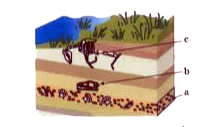
Identify the fossils in successive layer a, b, and c.02:14View Solution
What is your conclusion from this diagram ?04:28View Solution
Which diagram is correctly explained how does evolution proceed ? Why ?03:03View Solution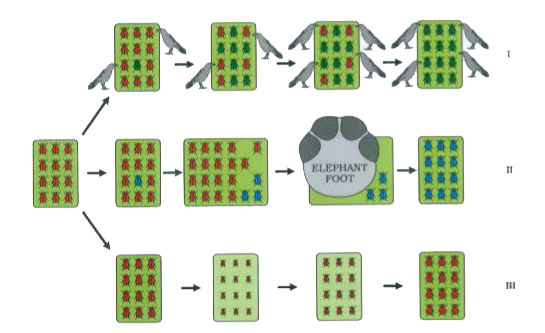
From the diagram, state the result in case I, II and III.04:42View SolutionMatch the following :
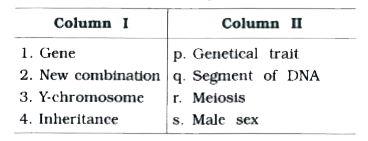 04:29View Solution
04:29View SolutionMatch the following :
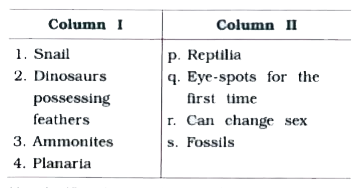 02:38View Solution
02:38View SolutionMatch the following :
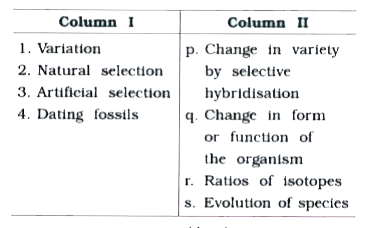 03:35View Solution
03:35View SolutionMatch the following :
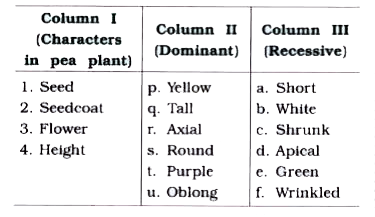 01:53View Solution
01:53View SolutionMatch the following :
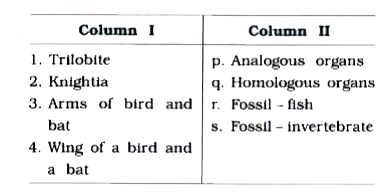 04:16View Solution
04:16View SolutionWhen hybridisation is carried out between a tall (TT) pea plant and a short (tt) pea plant, all the plants (offsprings) show the expression of tallness, because ………………….... a.the expression of tallness is dominant. b.the expression of short is dominant. c.the expression of tallness is recessive. d.the character of tallness in pea plant is not controlled by gene T or t.
04:12View SolutionStudy following statements (P to R) and choose the correct alternative :
P: Those organs which have the same internal structure but different functions are called homologous organs.
Q: Organs which have different basic design but have similar appearance and carry out similar functions are called analogous organs.
R: The impressions of dead plants or animals that lived in the past are known as fossils. a.Only R is true. b.All the three statements are true. c.Statements P and Q are true, but R is false. d.All the three statements are false.03:59View SolutionWhich is a false statement for variation ? a.All the variations in a species provide equal opportunity for survival. b.Very few variations are generated in asexual reproduction. c.Variations selected by the environmental factors cause the occurrence of evolution. d.The change in the genetic material (DNA) results in variation.
04:06View SolutionWhat do the examples of Dinosaurs having feathers and the birds having feathers suggest in the study of evolution ? a.The reptiles have been evolved from Aves. b.The Aves have been evolved from reptiles. c.Both are the animals of the same class. d.There is no evolutionary relationship between these two groups of animals.
03:32View SolutionWhich scientist was the first to conduct systematic experiments for the study of heredity ? a.Watson b.Sutton c.Mendel d.Khorana
01:37View SolutionWhich factor conducts the expressive genetic information from one generation to another? a.Protein b.DNA c.RNA d.Enzyme
02:27View SolutionWhich one of the following is not homologous?
03:33View SolutionThe Dinosaurs having feathers, belong to class ……………………………..
01:16View Solution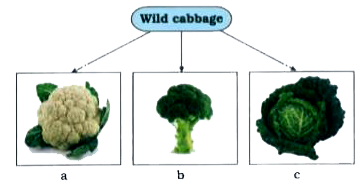
Name the diagrams a, b and c and from which part of the wild cabbage are they obtained ? Which method is used for obtaining these ?03:20View SolutionFrom where the genetic footprints of Homo sapiens can be traced ?
01:03View SolutionWhich is the important factor for the formation of new species?
04:30View SolutionIn the result of Mendel's experiment on the inheritance of two characters, the ratio of the plants showing yellow and wrinkled seeds and of the plants showing green and round seeds in `F_(2)` generation is …………….....
06:18View SolutionFrom where the genetic footprints of Homo sapiens can be traced ?
01:03View SolutionIn which animal did the eyes originate first ? a.Paramoecium b.Plasmodium c.Planaria d.Peripatus
01:32View SolutionWhich organ of fish is homologous with the hand of human being?
02:29View SolutionHow many types of sperms are found in man? a.One b.Two c.Three d.Four
01:18View SolutionThe Y-chromosome in human male ……………….. a.possesses the same size as that of X-chromosome. b.is larger in size than that of X-chromosome. c.is smaller in size than that of X-chromosome. d.is of double the size than that of X-chromosome.
01:43View SolutionWho conducted studies on role of earthworms in soil fertility? a.Mendel b.Miller c.Urey d.Darwin
01:27View SolutionThe organs which perform different functions but have the same basic structure are known a.Homologous organs b.Analogous organs c.Homolytic organ d.Analytic organ
01:42View SolutionIf the fossil of an organism is found in the deeper layer of earth, then we can predict that ................ a.the extinction of organism has occurred recently. b.the extinction of organism has occurred thousands of years ago. c.the fossil position in the layers of earth is not related to its time of extinction. d.time of extinction cannot be determined.
03:17View SolutionNew species may be formed if:
( 1 ) DNA undergoes significant changes in germ cells.
(2) there is no change in the genetic material.
(3)mating does not take place. a.(1) and (2) b.(1) c.( 2) and (3) d.(1 ), (2) and (3)04:28View SolutionThe presence of which of the following types of organs in two animals indicates that they are not derived from a common ancestor ? a.Homologous organs b.Excretory organs c.Analogous organs d.Reproductive organs
02:32View Solution
OBJECTIVE QUESTIONS AND ANSWERS questions and complete solutions for chapter HEREDITY AND EVOLUTION of KUMAR PRAKASHAN of Class 10
All Exercises from KUMAR PRAKASHAN Class 10 BIOLOGY HEREDITY AND EVOLUTION
- ADDITIONAL QUESTIONS AND ANSWERS
- OBJECTIVE QUESTIONS AND ANSWERS
- OBJECTIVE QUESTIONS AND ANSWERS (Answer as directed : (Miscellaneous))
- OBJECTIVE QUESTIONS AND ANSWERS (Answer the following questions in short : )
- OBJECTIVE QUESTIONS AND ANSWERS (Fill in the blanks: )
- OBJECTIVE QUESTIONS AND ANSWERS (Graph-diagram based questions : )
- OBJECTIVE QUESTIONS AND ANSWERS (Select the correct alternative from those given below each question: )
- OBJECTIVE QUESTIONS AND ANSWERS (State whether the following statements are true or false : )
- PRACTICAL SKILL BASED QUESTIONS WITH ANSWERS
- QUESTIONS AND ANSWERS
- TEXTUAL EXERCISE
- VALUE BASED QUESTIONS WITH ANSWERS
